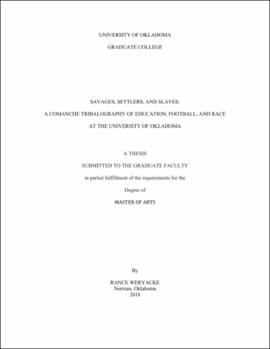| dc.description.abstract | This thesis utilizes the Sigma Alpha Episilon (SAE) incident on March 7th, 2015, as a way to open discussion regarding race, football, and the University of Oklahoma, connecting the university’s response to the situation to the experiences of Indian students, among them, Indian football players, at University of Oklahoma over the years. The thesis uses LeAnne Howe’s Tribalography as a framework for telling an Indian side of the story grounded in the geographic location that the University of Oklahoma currently occupies and for exploring how this story intersects currently as well as historically with the school’s football program. This “TribalOUgraphy”—the body of the thesis—narrates the intertribal story of the University of Oklahoma and of OU football from my individual Numunu, Comanche, perspective. The thesis describes the changes in dynamics in the state brought about by the Land Run of 1889, which “began the deposal of the federal public domain in Oklahoma” (Oklahoma Historical Society website). The nicknames Boomers and the Sooners originate from the time period. It also includes the story of the University of Oklahoma’s founding shortly after that, with OU football beginning in 1895, making both the university and the football program older than the state, which wasn’t formed from the two territories until 1907. The tribalography continues with an analysis of Lil’ Red, the Indian mascot used by the University of Oklahoma from 1957 to the early 1970s, reappearing in 1984. The thesis also details the history of Natives playing football at OU—from Key Wolf to Sam Bradford— and contextualizes this with a general history of Natives in football, such as the innovations in sport during the time of Jim Thorpe and the Carslisle team. The thesis concludes by focusing on the advances made by the University of Oklahoma in regard to education, race, and football since the SAE incident. | en_US |
